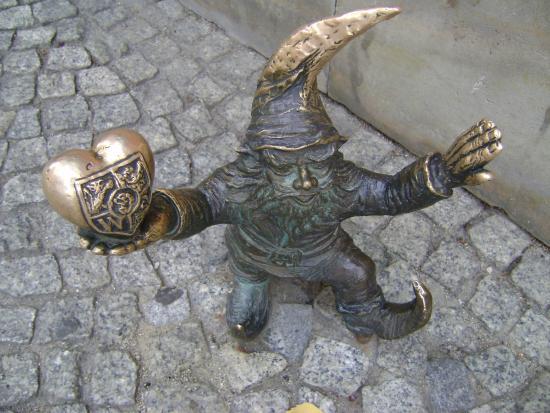The little-known town of Wroclaw is sprouting dwarves. The most recent audit has their number at 573 in this town, the capital of Lower Silesia, a province that straddles Poland, Germany and the Czech Republic. Prior to the Second World War, this was Breslau in Germany, but the borders of Poland were moved West by Stalin. East Poland became part of Ukraine and the east of the new state of East Germany became part of the new Poland. In fact, Poland claimed back of their ancient lands. The Poles from the East were relocated to the West, but not all the Germans moved to East Germany and so in West Poland the signage is in both German and Polish.
The BRASS dwarves, about 200 mm high, are engaged in the ordinary activities
The dwarves, made of brass and about 200 mm high, are engaged in the ordinary activities of everyday life, watching the television, using the ATM, playing in an orchestra, climbing lamp posts. Mostly there are male dwarves, but there are some female ones serving pancakes, looking after baby dwarves, and playing in the orchestra.
But these brass beauties were not the first known Wroclaw dwarves. I expected a story or myth, not unlike the one that lies behind the dragon of Krakow. How wrong we were.
The first brass dwarf appeared in 2001 as street art with a large middle fingernail pointed vertically with a larger dwarf standing on top with a wry smile and proud pose. This was the first brass dwarf of Wroclaw and prompted the larger dwarf movement that followed. He is not bearded, but all the others are smaller, with beards, and pointed hats, sometimes in some disarray because parts of them have been stolen.

This photo of Wroclaw’s Dwarfs is courtesy of TripAdvisor
The next 20 or so dwarves, which popped up in 2005, were municipally funded. The first crop was soon overrun by corporate dwarves who advertise the wares of the place they stand or sit outside. A corporate dwarf attracts tax, by the way. Apparently, artists create “rogue dwarves” and place them at will, however, we did not see any. Some get stolen, but most are now fitted with GPS trackers.
But why dwarves?
It turns out the dwarves are a play on words and have a revolutionary and subversive meaning. In the mid-1980s, Poland was a satellite state of the communist Soviet Union. While most Poles hated the Russian rule, those faithful to Communism wore red.
Amid much anti-Soviet activity at the time, the anti-communists wrote slogans on walls. The authorities whited them out. The Orange Alternative – the subversive and humorous name for the anti-communist movement in Wroclaw – replaced the slogans with images of dwarves.
This photo of Wroclaw’s Dwarfs is courtesy of TripAdvisor
It was a wordplay. In Russian, the word “krasny” means red. In Polish, the word “krasna” means dwarf! As we tracked down the little brass fellas (which cost about US$1000 to produce) I got a lesson on revolutionary action and revolution history. This defiance gave the colour to my experience of Wroclaw; friendly, quirky, with many wonderful sites.
Follow me



































